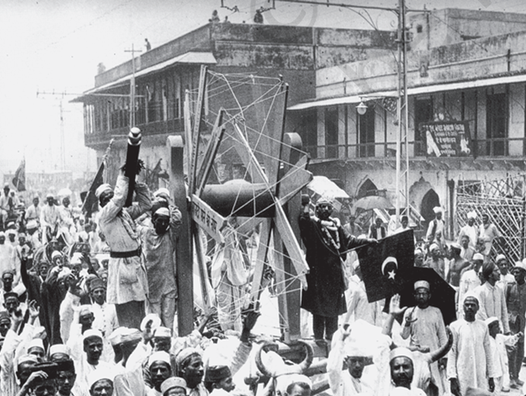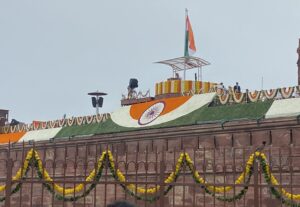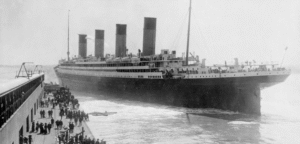The Swadeshi Movement was a pivotal socio-economic and political campaign in India during the early 20th century, aimed at promoting self-reliance and resisting British colonial rule. It emerged as part of the broader Indian independence movement and was particularly significant during the agitation against the partition of Bengal (1905–1911). The movement emphasized the use of indigenous goods, the boycott of British products, and the promotion of national education and self-governance. Below are the complete details of the Swadeshi Movement, including its background, objectives, methods, key figures, impact, and legacy.
Background
- Partition of Bengal (1905):
- The British government, under Viceroy Lord Curzon, announced the partition of Bengal in 1905, ostensibly for administrative convenience.
- Bengal, a large and culturally unified province, was divided into two parts: Eastern Bengal and Assam (with a Muslim majority) and West Bengal (with a Hindu majority).
- The partition was widely perceived as a “divide and rule” strategy to weaken the growing nationalist sentiment in Bengal, a hotbed of anti-colonial activism.
- The decision sparked widespread protests, as Bengalis saw it as an attack on their cultural, linguistic, and political unity.
- Rise of Nationalism:
- By the early 1900s, Indian nationalism was gaining momentum, with leaders like Bal Gangadhar Tilak, Bipin Chandra Pal, and Aurobindo Ghosh advocating for more assertive resistance against British rule.
- The Indian National Congress (INC), founded in 1885, had initially adopted moderate methods like petitions and resolutions, but the partition of Bengal radicalized the movement, giving rise to the Extremist faction within the Congress.
- Economic Context:
- British colonial policies had devastated India’s indigenous industries, particularly textiles, through heavy taxation, import duties, and the flooding of the Indian market with British goods.
- The exploitation of Indian resources and labor fueled resentment, as Indians were reduced to suppliers of raw materials while being forced to buy expensive British manufactured goods.
- Inspiration from Earlier Movements:
- The Swadeshi Movement drew inspiration from earlier self-reliance efforts, such as Bal Gangadhar Tilak’s call for boycotts during the 1890s and the writings of Rabindranath Tagore and Bankim Chandra Chattopadhyay, which emphasized cultural pride and economic independence.
Objectives of the Swadeshi Movement
The Swadeshi Movement had both economic and political goals, aiming to foster self-reliance while challenging British authority. Its main objectives were:
- Economic Self-Sufficiency:
- Promote the use of Indian-made goods (Swadeshi) and boycott British goods (especially textiles, sugar, and other manufactured products).
- Revive indigenous industries, particularly handloom textiles, to provide employment and reduce dependence on British imports.
- Political Awakening:
- Mobilize the masses against British rule and build a sense of national unity.
- Oppose the partition of Bengal and demand its annulment.
- Strengthen the nationalist movement by encouraging active resistance rather than passive petitions.
- Cultural and Educational Revival:
- Promote Indian culture, languages, and traditions as a counter to British cultural domination.
- Establish national education systems free from British control to foster patriotic values and self-respect.
- Social Reform:
- Address social issues like caste discrimination and promote unity among Hindus and Muslims in the fight against colonial rule.
Methods and Strategies
The Swadeshi Movement employed a range of strategies to achieve its goals, combining economic resistance, political agitation, and cultural revival:
- Boycott of British Goods:
- Indians were urged to boycott British-made goods, particularly textiles, salt, sugar, and luxury items.
- Public bonfires of foreign cloth became a symbolic act of defiance, with people pledging to wear only khadi (hand-spun cloth).
- Promotion of Swadeshi Products:
- Indigenous industries were revived, with a focus on handloom textiles, soap, matches, and other goods.
- Swadeshi stores and cooperatives were established to sell Indian-made products.
- Leaders encouraged the use of traditional crafts and skills to boost local economies.
- Mass Mobilization:
- The movement saw widespread participation from diverse groups, including students, women, peasants, and urban professionals.
- Public meetings, rallies, and processions were organized to spread the message of Swadeshi and boycott.
- Songs, poetry, and plays by figures like Rabindranath Tagore (e.g., the song Amar Sonar Bangla, later the national anthem of Bangladesh) inspired patriotic fervor.
- National Education:
- The movement rejected British-controlled education, which was seen as a tool of cultural subjugation.
- National schools and colleges were established, such as the Bengal National College in Calcutta, to provide education rooted in Indian values.
- Leaders like Aurobindo Ghosh and Satyendranath Bose played key roles in promoting national education.
- Passive Resistance and Non-Cooperation:
- The movement advocated passive resistance, such as refusing to cooperate with British authorities, resigning from government jobs, and boycotting British institutions.
- Strikes (hartals) and protests were organized to disrupt colonial administration.
- Cultural Revival:
- Festivals, dramas, and literature were used to celebrate Indian heritage and resist British cultural influence.
- The movement emphasized the use of regional languages and the preservation of traditional arts and crafts.
Key Figures
The Swadeshi Movement was led by a range of prominent leaders, both from the Extremist and Moderate factions of the Indian National Congress, as well as cultural figures.
- Bal Gangadhar Tilak:
- A leading Extremist leader, Tilak popularized the slogan “Swaraj is my birthright, and I shall have it.”
- He advocated for mass agitation and boycotts, emphasizing self-reliance as a tool for political freedom.
- Bipin Chandra Pal:
- A key figure in Bengal, Pal called for complete economic and political independence through Swadeshi and boycott.
- Lala Lajpat Rai:
- Known as the “Lion of Punjab,” he played a major role in mobilizing support in northern India.
- Together with Tilak and Pal, he formed the Lal-Bal-Pal triumvirate of Extremist leaders.
- Aurobindo Ghosh:
- A revolutionary leader and philosopher, Ghosh wrote fiery articles in journals like Bande Mataram, inspiring the youth to join the movement.
- He later withdrew from active politics to focus on spiritual pursuits.
- Rabindranath Tagore:
- The Nobel laureate poet contributed through his writings and songs, promoting Bengali culture and unity.
- He initially supported the movement but later criticized its divisiveness, particularly its impact on Hindu-Muslim relations.
- Surendranath Banerjee:
- A Moderate leader, Banerjee initially supported the movement but favored constitutional methods over mass agitation.
- Gopal Krishna Gokhale:
- A Moderate Congress leader, Gokhale was skeptical of the Extremists’ methods but supported the broader goal of self-reliance.
Spread of the Movemen
- The Swadeshi Movement began in Bengal but quickly spread to other parts of India, including Punjab, Maharashtra, Uttar Pradesh, Madras, and Bihar.
- In Bengal, the movement was particularly intense, with students playing a key role in organizing boycotts and protests.
- In Maharashtra, Tilak mobilized support through festivals like Ganesh Chaturthi, using them as platforms for nationalist propaganda.
- In Punjab, Lala Lajpat Rai led protests and encouraged the boycott of British goods.
- In southern India, leaders like V.O. Chidambaram Pillai established Swadeshi enterprises, such as the Swadeshi Steam Navigation Company, to compete with British shipping firms.
Impact of the Swadeshi Movement
The Swadeshi Movement had far-reaching effects on India’s independence struggle, economy, and society:
Economic Impact:
- Revival of Indigenous Industries:
- The movement led to a resurgence of Indian industries, particularly handloom textiles and small-scale manufacturing.
- Companies like the Bangalore Swadeshi Stores and Tata Iron and Steel Company (founded in 1907) were inspired by the movement’s focus on self-reliance.
- Decline in British Imports:
- The boycott significantly reduced imports of British goods, particularly textiles, causing economic losses for British manufacturers.
- For example, the import of British cloth to Bengal dropped by about 25% between 1905 and 1908.
Political Impact:
- Radicalization of the Freedom Struggle:
- The movement marked a shift from moderate constitutional methods to mass-based, assertive resistance.
- It laid the groundwork for future movements like Gandhi’s Non-Cooperation Movement (1920–1922) and Civil Disobedience Movement (1930–1934).
- Split in the Congress (1907):
- The ideological differences between the Moderates and Extremists came to a head during the movement, leading to the Surat Split of the Indian National Congress in 1907.
- The Extremists, led by Tilak, Pal, and Rai, were expelled, but their ideas gained wider acceptance over time.
- Annulment of the Partition (1911):
- The sustained protests and boycotts forced the British to annul the partition of Bengal in 1911, reuniting the province.
- However, the capital of British India was shifted from Calcutta to Delhi in 1911, partly to weaken Bengal’s political influence.
Social and Cultural Impact:
- National Consciousness:
- The movement fostered a sense of national identity and pride, uniting people across regions and communities.
- It popularized the concept of Swaraj (self-rule) as a tangible goal for the independence movement.
- Women’s Participation:
- Women played an active role, participating in picketing, boycotts, and Swadeshi fairs, marking their entry into the public sphere of the freedom struggle.
- Cultural Revival:
- The movement revived interest in Indian art, literature, and traditions, countering the cultural alienation imposed by British rule.
- Institutions like the Bengal School of Art, led by Abanindranath Tagore, emphasized indigenous artistic traditions.
- British Repression:
- The British responded with harsh measures, including arrests, lathi charges, and the deportation of leaders like Tilak and Lajpat Rai.
- Laws like the Seditious Meetings Act (1907) and the Indian Press Act (1910) were enacted to curb protests and censor the press.
- The repression led some activists to turn to revolutionary methods, giving rise to groups like the Anushilan Samiti and Jugantar, which engaged in armed resistance.
Limitations and Challenges
- Hindu-Muslim Divide:
- The movement initially aimed to unite Hindus and Muslims, but communal tensions emerged over time.
- Some Muslim leaders, like Nawab Salimullah of Dhaka, supported the partition of Bengal, as it gave Muslims in Eastern Bengal a political advantage.
- The use of Hindu religious symbols (e.g., songs like Vande Mataram) alienated some Muslims, contributing to the growth of communal politics.
- The All-India Muslim League, founded in 1906, gained traction during this period, advocating for separate Muslim interests.
- Economic Constraints:
- Indian industries struggled to meet the demand for goods, as they lacked the scale and technology to compete with British manufacturers.
- Swadeshi products, such as khadi, were often more expensive than British goods, making them inaccessible to the poor.
- Limited Participation of the Masses:
- While the movement mobilized urban middle classes and students, its reach among rural peasants and workers was limited.
- The focus on boycotts and Swadeshi goods was less relevant to the rural poor, who were more concerned with issues like land revenue and tenancy rights.
- British Repression:
- The British crackdown weakened the movement, with many leaders imprisoned or deported.
- The lack of a unified strategy after the Surat Split also hampered its momentum.
- Decline by 1908:
- By 1908, the movement began to lose steam due to internal divisions, British repression, and economic challenges.
- However, its ideas and methods continued to influence later phases of the freedom struggle.
Legacy of the Swadeshi Movement
- Foundation for Future Movements:
- The Swadeshi Movement laid the groundwork for Gandhi’s philosophy of self-reliance and nonviolent resistance.
- Gandhi later adopted Swadeshi and the boycott of foreign goods as key components of the Non-Cooperation Movement (1920–1922) and the promotion of khadi through the All India Spinners’ Association.
- Economic Nationalism:
- The movement instilled a sense of economic nationalism, encouraging Indians to support indigenous industries and reduce dependence on foreign goods.
- This idea influenced post-independence economic policies, such as India’s focus on self-sufficiency and import substitution in the 1950s and 1960s.
- Cultural and Educational Institutions:
- The national education movement led to the establishment of institutions like Visva-Bharati University (founded by Rabindranath Tagore) and the Gujarat Vidyapith (later founded by Gandhi).
The cultural revival inspired a renewed interest in Indian art, literature, and traditions.
Political Awakening:
The movement marked a turning point in the Indian freedom struggle, shifting the focus from elite-led petitions to mass mobilization.
It inspired future generations of freedom fighters and set the stage for more radical movements in the 1920s and 1930s.
Global Influence:
The Swadeshi Movement’s emphasis on boycott and self-reliance influenced other anti-colonial movements, such as the Irish Sinn Féin movement, which adopted similar strategies against British rule.
Conclusion
The Swadeshi Movement was a transformative phase in India’s struggle for independence, combining economic resistance, political agitation, and cultural revival to challenge British colonial rule. While it began as a protest against the partition of Bengal, it evolved into a broader movement for self-reliance and national unity. Despite its limitations, such as communal tensions and economic challenges, the movement succeeded in awakening national consciousness, radicalizing the freedom struggle, and laying the foundation for future campaigns under leaders like Mahatma Gandhi. Its legacy of economic nationalism and cultural pride continues to resonate in modern India, where the principles of Swadeshi are often invoked in discussions of self-reliance and sustainable development.
- The national education movement led to the establishment of institutions like Visva-Bharati University (founded by Rabindranath Tagore) and the Gujarat Vidyapith (later founded by Gandhi).















Leave a Reply